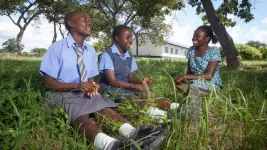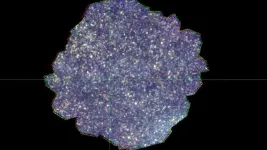(Press-News.org) WASHINGTON (April 9, 2025) — A new study from researchers at the George Washington University has found that certain bacteria living in the nose may influence how likely someone is to get a COVID-19 infection. Published in EBioMedicine, the research reveals that certain types of nasal bacteria can affect the levels of key proteins the virus needs to enter human cells, offering new insight into why some people are more vulnerable to COVID-19 than others.
“We’ve known that the virus SARS-CoV-2 enters the body through the respiratory tract, with the nose being a key entry point. What’s new—and surprising—is that bacteria in our noses can influence the levels of proteins that the virus uses to infect cells,” said Cindy Liu, associate professor of environmental and occupational health at the GW Milken Institute School of Public Health.
Higher Gene Expression of Viral Entry Proteins Increases COVID-19 Infection Risk
In the study, Liu and her team analyzed nasal swab samples from over 450 people, including some who later tested positive for COVID-19. They found that those who became infected had higher levels of gene expression for two key proteins — ACE2 and TMPRSS2. ACE2 allows the virus to enter nasal cells, while TMPRSS2 helps activate the virus by cleaving its spike protein.
Those with high expression for these proteins were more than three times as likely to test positive for COVID-19, while those with moderate levels had double the risk. The study also found that people who became infected had more unstable levels of gene expression, with the sharpest increases just days before testing positive, suggesting rising expression levels may signal increased vulnerability to the virus.
Notably, while women generally had higher gene expression levels of these proteins — consistent with previous studies showing higher COVID-19 infection rates in women — men with higher levels were more likely to get infected, indicating elevated protein levels may present a greater risk for men.
Nasal Bacteria May Play a Role in COVID-19 Risk
To understand what could impact the expression levels of these viral entry proteins, the researchers turned to the nasal microbiome — the diverse community of bacteria that naturally reside in the nose. They found that certain nasal bacteria may affect the expression levels of ACE2 and TMPRSS2, influencing the respiratory tract’s susceptibility to COVID-19.
The study identified three common nasal bacteria—Staphylococcus aureus, Haemophilus influenzae, and Moraxella catarrhalis/nonliquefaciens—that were linked to higher expression levels of ACE2 and TMPRSS2 and increased COVID-19 risk. On the other hand, Dolosigranulum pigrum, another common type of nasal bacteria, was connected to lower levels of these key proteins and may offer some protection against the virus.
“Some bacteria in your nose may be setting the stage — or even holding the door open — for viruses like SARS-CoV-2 to get in,” said Daniel. Park, a senior research scientist at GW and the first author of the study.
While some of the high-risk bacteria were less common, 20% of participants carried enough S. aureus to nearly double their risk for having elevated ACE2 and TMPRSS2 expression, making it a major nasal microbiome risk factor for increasing individuals’ risk for COVID-19 infection.
Why This Matters
The findings offer new potential ways to predict and prevent COVID-19 infection. The study suggests that monitoring ACE2 and TMPRSS2 gene expression could help identify individuals at higher risk for infection. The research also highlights the potential of targeting the nasal microbiome to help prevent viral infections.
“We’re only beginning to understand the complex relationship between the nasal microbiome and our health,” said Liu. “This study suggests that the bacteria in our nose—and how they interact with the cells and immune system in our nasal cavity—could play an important role in determining our risk for respiratory infections like COVID-19.”
The team plans to explore whether modifying the nasal microbiome, such as through nasal sprays or live biotherapeutics, could reduce the risk of infection — potentially paving the way for new ways to prevent respiratory viral infections in future pandemics.
The study, The Nasal Microbiome Modulates Risk for SARS-CoV-2 Infection, was published April 9 in the journal EBioMedicine. The research was supported by the GW Milken Institute School of Public Health and by the National Institutes of Health.
END
Certain nasal bacteria may boost the risk for COVID-19 infection, study finds
New research uncovers how bacteria in the nose may play a role in making the respiratory tract more vulnerable to COVID-19 infection
2025-04-10
ELSE PRESS RELEASES FROM THIS DATE:
Europe's population is adapting better to cold than to heat
2025-04-09
A study led by the Barcelona Institute for Global Health (ISGlobal), a centre supported by the "la Caixa" Foundation, has shown that Europe has adapted better to low temperatures than to high temperatures over the last two decades. The research, carried out in collaboration with the Barcelona Supercomputing Centre (BSC) and published in The Lancet Planetary Health, shows that there has been a significant decrease in cold-related mortality risk in recent years compared to the first decade of the 2000s. There has also been a reduction in the risk of heat-related ...
Ancient tools from a South African cave reveal connections between prehistoric people
2025-04-09
In a cave overlooking the ocean on the southern coast of South Africa, archaeologists discovered thousands of stone tools, created by ancient humans roughly 20,000 years ago. By examining tiny details in the chipped edges of the blades and stones, archaeologists are able to tell how the tools were made. In a new study published in the Journal of Paleolithic Archaeology, researchers analyzed these stone tools and discussed how the different techniques used to make them hint at the ways that prehistoric people traveled, interacted, and shared their craft.
“This is an important insight into how people who lived in this region ...
World’s first birth following conception with a fully automated remotely operated ICSI system
2025-04-09
10 April 2025: The world’s first baby has been born following conception with a fully automated, digitally controlled intracytoplasmic sperm injection (ICSI) system. ICSI, developed and adopted into widespread use in the 1990s and now a routine method of assisted conception, achieves fertilisation by injecting a single sperm cell into the centre of a mature egg.
The details are reported today in the peer-review medical journal Reproductive Biomedicine Online.(1) The automated system was described and developed by a multidisciplinary team of specialists from Conceivable ...
Girls’ education projects succeed when whole communities ‘live the change’ and carry it forward
2025-04-09
Education projects supporting marginalised girls in lower-income countries are more likely to achieve lasting transformations when they mobilise young women and their communities as “agents of change”, a new report indicates.
The recommendation comes from the latest evaluation of the Girls’ Education Challenge: a UK Government-supported initiative which has funded projects reaching more than 1.6 million girls. The University of Cambridge-led study finds that these projects initiated “virtuous cycles” of change – particularly by rooting themselves in communities and empowering young women to lead the way.
In ...
European bird declines linked to range of climatic conditions experienced
2025-04-09
New research suggests conservation efforts could more effectively identify and protect bird species at greatest risk from climate change by better understanding the range of specific conditions they need to thrive.
The study, led by the University of East Anglia (UEA), examined the relationship between the extent of the climatic conditions that species tolerate and in which populations can survive - known as climatic niche breadth - and their likelihood of declining in response to climate change.
For species inhabiting a similar area of geographic space, those able to tolerate ...
'Hidden galaxies' could be smoking gun in universe riddle
2025-04-09
Astronomers have peered back in time to find what looks like a population of 'hidden' galaxies that could hold the key to unlocking some of the universe's secrets.
If their existence is confirmed it would "effectively break current models of galaxy numbers and evolution".
The possible galaxies may also provide the missing piece of the puzzle for the energy generation in the universe in infrared light.
That's because their combined light would be enough to top-up the energy budget of the universe to the maximum we observe, effectively ...
Love songs in the sand: researchers listen in to Fiddler crab courtship
2025-04-09
UNDER EMBARGO UNTIL 00:01 BST THURSDAY 10 APRIL / 19:01 ET WEDNESDAY 9 APRIL 2025
For the first time, a study led by University of Oxford researchers has ‘listened in’ to the fascinating courtship displays of Fiddler crabs using geophones. The findings, published today in the Journal of Experimental Biology, provide new insights into how the animals communicate effectively on the noisy seashore.
For male fiddler crabs, vibrational signals are a crucial part of their courtship routines – produced by drumming the ground using their oversized claw, ...
Study suggests lean muscle mass loss can be minimized during weight loss therapy using newer incretin obesity drugs
2025-04-09
New research to be presented at this year’s European Congress on Obesity (ECO 2025, Malaga, Spain, 11-14 May) shows that patients using GLP-1 or combined GLP-1 / GIP receptor agonist therapy for weight loss experienced minimal lean muscle mass loss as they lost weight across 6 months of treatment. The study is by Dr Dinabel Peralta-Reich, Donald and Barbara Zucker School of Medicine at Hofstra/Northwell; Lenox Hill Hospital, Northwell Health, New York City, NY, USA, and Dr Alexandra Filingeri, New York Weight Wellness Medicine, New York City, NY, USA, and colleagues.
GLP-1 (glucagon-like peptide-1) receptor agonists, ...
Aussie tech helps make bio-oils for greener industrial applications
2025-04-09
Australian technology developed at RMIT University could enable more sustainable and cheaper production of bio-oils to replace petroleum-based products in electronic, construction and automotive applications.
The technology, known as PYROCOTM, uses high temperatures without oxygen to convert treated sewage (biosolids) into a carbon-rich product called biochar, which can act as a catalyst to produce phenol-rich bio-oil.
PYROCOTM has been developed by RMIT in collaboration with South East Water, Intelligent Water Networks and other water authorities over several years and is now being applied to several exciting circular economy applications.
The RMIT team's latest research in collaboration ...
Map of genetic regulation in chickens could help fight against bird flu
2025-04-09
An international team of researchers led by Professor Huaijun Zhou from the UC Davis Department of Animal Science has created the first-ever detailed map of how genes are regulated in chickens — a breakthrough that could help scientists breed birds that are more resistant to diseases like avian influenza.
The study, published April 8 in Nature Genetics, brings together a massive amount of genetic and epigenetic data of more than 100 chicken breeds from around the world. The team, which ...
LAST 30 PRESS RELEASES:
Germline pathogenic variants among women without a history of breast cancer
Tanning beds triple melanoma risk, potentially causing broad DNA damage
Unique bond identified as key to viral infection speed
Indoor tanning makes youthful skin much older on a genetic level
Mouse model sheds new light on the causes and potential solutions to human GI problems linked to muscular dystrophy
The Journal of Nuclear Medicine ahead-of-print tip sheet: December 12, 2025
Smarter tools for peering into the microscopic world
Applications open for funding to conduct research in the Kinsey Institute archives
Global measure underestimates the severity of food insecurity
Child survivors of critical illness are missing out on timely follow up care
Risk-based vs annual breast cancer screening / the WISDOM randomized clinical trial
University of Toronto launches Electric Vehicle Innovation Ontario to accelerate advanced EV technologies and build Canada’s innovation advantage
Early relapse predicts poor outcomes in aggressive blood cancer
American College of Lifestyle Medicine applauds two CMS models aligned with lifestyle medicine practice and reimbursement
Clinical trial finds cannabis use not a barrier to quitting nicotine vaping
Supplemental nutrition assistance program policies and food insecurity
Switching immune cells to “night mode” could limit damage after a heart attack, study suggests
URI-based Global RIghts Project report spotlights continued troubling trends in worldwide inhumane treatment
Neutrophils are less aggressive at night, explaining why nighttime heart attacks cause less damage than daytime events
Menopausal hormone therapy may not pose breast cancer risk for women with BRCA mutations
Mobile health tool may improve quality of life for adolescent and young adult breast cancer survivors
Acupuncture may help improve perceived breast cancer-related cognitive difficulties over usual care
Nerve block may reduce opioid use in infants undergoing cleft palate surgery
CRISPR primes goldenberry for fruit bowl fame
Mass General Brigham announces new AI company to accelerate clinical trial screening and patient recruitment
Fat tissue around the heart may contribute to greater heart injury after a heart attack
Jeonbuk National University researcher proposes a proposing a two-stage decision-making framework of lithium governance in Latin America
Chromatin accessibility maps reveal how stem cells drive myelodysplastic progression
Cartilaginous cells regulate growth and blood vessel formation in bones
Plant hormone allows lifelong control of proteins in living animal for first time
[Press-News.org] Certain nasal bacteria may boost the risk for COVID-19 infection, study findsNew research uncovers how bacteria in the nose may play a role in making the respiratory tract more vulnerable to COVID-19 infection






